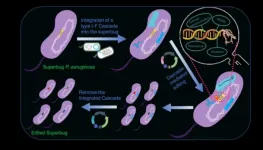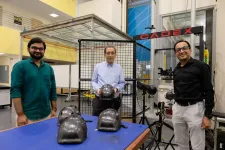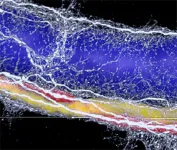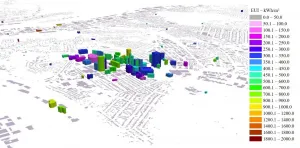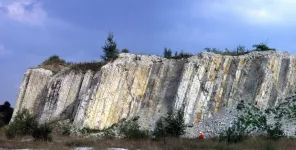(Press-News.org) The touchscreen technology used in billions of smartphones and tablets could also be used as a powerful sensor, without the need for any modifications.
Researchers from the University of Cambridge have demonstrated how a typical touchscreen could be used to identify common ionic contaminants in soil or drinking water by dropping liquid samples on the screen, the first time this has been achieved. The sensitivity of the touchscreen sensor is comparable to typical lab-based equipment, which would make it useful in low-resource settings.
The researchers say their proof of concept could one day be expanded for a wide range of sensing applications, including for biosensing or medical diagnostics, right from the phone in your pocket. The results are reported in the journal Sensors and Actuators B.
Touchscreen technology is ubiquitous in our everyday lives: the screen on a typical smartphone is covered in a grid of electrodes, and when a finger disrupts the local electric field of these electrodes, the phone interprets the signal.
Other teams have used the computational power of a smartphone for sensing applications, but these have relied on the camera or peripheral devices, or have required significant changes to be made to the screen.
"We wanted to know if we could interact with the technology in a different way, without having to fundamentally change the screen," said Dr Ronan Daly from Cambridge's Institute of Manufacturing, who co-led the research. "Instead of interpreting a signal from your finger, what if we could get a touchscreen to read electrolytes, since these ions also interact with the electric fields?"
The researchers started with computer simulations, and then validated their simulations using a stripped down, standalone touchscreen, provided by two UK manufacturers, similar to those used in phones and tablets.
The researchers pipetted different liquids onto the screen to measure a change in capacitance and recorded the measurements from each droplet using the standard touchscreen testing software. Ions in the fluids all interact with the screen's electric fields differently depending on the concentration of ions and their charge.
"Our simulations showed where the electric field interacts with the fluid droplet. In our experiments, we then found a linear trend for a range of electrolytes measured on the touchscreen," said first author Sebastian Horstmann, a PhD candidate at IfM. "The sensor saturates at an anion concentration of around 500 micromolar, which can be correlated to the conductivity measured alongside. This detection window is ideal to sense ionic contamination in drinking water."
One early application for the technology could be to detect arsenic contamination in drinking water. Arsenic is another common contaminant found in groundwater in many parts of the world, but most municipal water systems screen for it and filter it out before it reaches a household tap. However, in parts of the world without water treatment plants, arsenic contamination is a serious problem.
"In theory, you could add a drop of water to your phone before you drink it, in order to check that it's safe," said Daly.
At the moment, the sensitivity of phone and tablet screens is tuned for fingers, but the researchers say the sensitivity could be changed in a certain part of the screen by modifying the electrode design in order to be optimised for sensing.
"The phone's software would need to communicate with that part of the screen to deliver the optimum electric field and be more sensitive for the target ion, but this is achievable," said Professor Lisa Hall from Cambridge's Department of Chemical Engineering and Biotechnology, who co-led the research. "We're keen to do much more on this - it's just the first step."
While it's now possible to detect ions using a touchscreen, the researchers hope to further develop the technology so that it can detect a wide range of molecules. This could open up a huge range of potential health applications.
"For example, if we could get the sensitivity to a point where the touchscreen could detect heavy metals, it could be used to test for things like lead in drinking water. We also hope in the future to deliver sensors for home health monitoring," said Daly.
"This is a starting point for broader exploration of the use of touchscreen sensing in mobile technologies and the creation of tools that are accessible to everyone, allowing rapid measurements and communication of data," said Hall.
INFORMATION:
Many applications, from fiber-optic telecommunications to biomedical imaging processes require substances that emit light in the near-infrared range (NIR). A research team in Switzerland has now developed the first chromium complex that emits light in the coveted, longer wavelength NIR-II range. In the journal Angewandte Chemie, the team has introduced the underlying concept: a drastic change in the electronic structure of the chromium caused by the specially tailored ligands that envelop it.
Many materials that emit NIR light are based on expensive or rare metal complexes. Cheaper alternatives that emit in the NIR-I range between 700 and 950 nm have been developed but NIR-II-emitting complexes of non-precious metals remain extremely rare. Luminescence in the NIR-II range (1000 to 1700 ...
A research team led by Wim Annaert (VIB-KU Leuven) uncovered the early assembly of gamma-secretase, a protein complex linked to numerous cellular processes including the development of Alzheimer's disease. In a first step, two dimeric subcomplexes are formed, which independently exit the ER and only afterwards assemble into a four-subunit complex. This 'buckle up' mechanism is thought to prevent premature assembly and activity. The new insights are very relevant, as gamma-secretase is an important potential therapeutic target for Alzheimer's and other ...
A research team led by Dr Aixin YAN, Associate Professor from the Research Division for Molecular & Cell Biology, Faculty of Science, in collaboration with Honorary Clinical Professor Patrick CY WOO from the Department of Microbiology, Li Ka Shing Faculty of Medicine, the University of Hong Kong (HKU), reported the development of a transferrable and integrative type I CRISPR-based platform that can efficiently edit the diverse clinical isolates of Pseudomonas aeruginosa, a superbug capable of infecting various tissues and organs and a major source of nosocomial infections. The ...
As cities worldwide expand their networks of cycling paths and more cyclists take to the streets, the chances of cycling accidents and potential collisions increase as well, underscoring the need for proper cycling safety in dense urban areas.
According to a World Health Organisation report in 2020, more than 60 per cent of the reported bicycle-related deaths and long-term disabilities are a result of accidents with head injuries.
Researchers from Nanyang Technological University, Singapore (NTU Singapore), in collaboration with French specialty materials leader Arkema, have developed a tougher, safer bicycle helmet using a combination of materials. The new helmet prototype has higher energy absorption, reducing the amount of energy ...
With the application of a novel three-dimensional imaging technology, researchers at Karolinska Institutet in Sweden have discovered that one portion of the autonomic nervous system in the liver undergoes severe degeneration in non-alcoholic fatty liver disease. The study, which is conducted in mice and human liver tissue, shows that the degeneration of nerves is correlated with the severity of liver pathology. The results are being published in the journal Science Advances.
Non-alcoholic fatty liver disease is the most common hepatic disorder, with prevalence around 25 percent globally. Approximately ...
The building sector in the U.S. accounts for 39 percent of energy use, with commercial buildings responsible for about half of that. As cities grapple with climate change, making commercial buildings more efficient is a key part of the solution.
Researchers at the University of Pittsburgh Swanson School of Engineering and the Mascaro Center for Sustainable Innovation used the City of Pittsburgh to create a model built upon the design, materials and purpose of commercial buildings to estimate their energy usage and emissions. While other models may ...
FRANKFURT/HANNOVER. The international team of geoscientists led by Prof. Silke Voigt from the Goethe University Frankfurt, Prof. Ireneusz Walaszczyk from the University of Warsaw and Dr André Bornemann from LBEG have thoroughly investigated 40 metres of the geological strata sequence in the former limestone quarry at Hasselberg. The researchers determined that this is only sequence in the transition between Turonian and Coniacian without gaps and it therefore represents a perfect rock sequence to serve geoscientists from all over the world as a reference for their research - a "Global Stratotype Section and Point (GSSP)" or, in the jargon of geosciences, a "golden nail".
Certain group of bivalve mollusks of the family Inoceramidae, first appeared in the Coniacian, and ...
ORLANDO, July 22, 2021 - Disagreement seems to spread online posts faster and further than agreement, according to a new study from the University of Central Florida.
The finding comes from an examination of posts labeled controversial on social news aggregation site Reddit. To perform the study, the researchers analyzed more than 47,000 posts about cybersecurity in a Reddit dataset that was collected by the Computational Simulation of Online Social Behavior (SocialSim) program of the U.S. Defense Advanced Research Projects Agency.
Researchers found that these posts were seen by nearly twice the number of people and traveled nearly twice as fast when compared ...
In a new study, published recently in the journal Circulation Research, scientists discover how the production of protective molecules known as specialised pro-resolving mediators (SPM) is altered in patients with COVID-19.
The results suggest that treatments which increase SPM production, such as dexamethasone or SPM based drugs, could play a key role in limiting inflammation in these patients.
Currently there is little understanding around the mechanisms that lead to uncontrolled inflammation in patients with COVID-19.
The study found a link between decreased SPM blood levels and disrupted white blood cell responses in patients with a higher disease burden. The findings also revealed that dexamethasone, the first drug ...
More than 820 million people in the world don't have enough to eat, while climate change and increasing competition for land and water are further raising concerns about the future balance between food demand and supply. The results of a new IIASA-led study can be used to benchmark global food security projections and inform policy analysis and public debate on the future of food.
Despite the fact that food supply has increased dramatically since the 1960s, the question of how to eradicate global hunger - one of the Sustainable Development Goals - and feed the growing world population in years to come, remains a major challenge. Climate change and increasing competition ...
